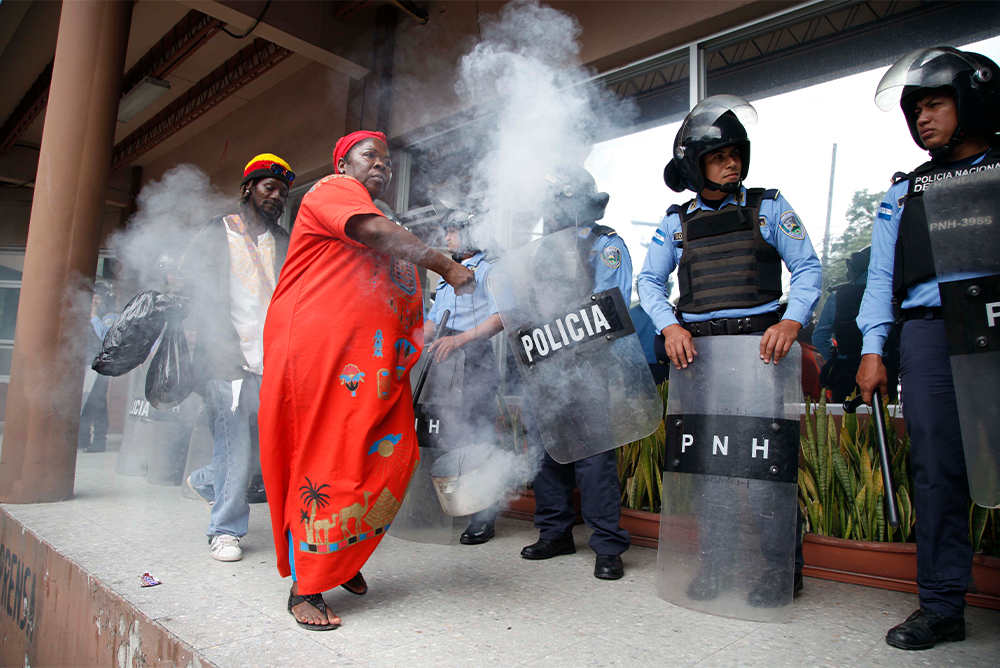
Honduras is one of the world’s most deadly countries for land defenders, especially those from Black- and Indigenous-descended Garifuna communities, writes anthropologist Christopher A. Loperena. Garifuna people protesting in Tegucigalpa, Honduras, in 2016. Courtesy of AP Newsroom.
On May 28, 2023, the body of Martín Morales Martínez was found floating in the Gama River in Triunfo de la Cruz, Honduras. Morales Martínez was Garifuna—a people descended from enslaved Africans, Arawak, and Carib Indians. He was also a respected land rights activist who devoted his life to fighting the theft of Garifuna coastal lands by corporations, investors, and state authorities. His was the most recent in a series of murders of Black and Indigenous land defenders in the country that show how violence, economic development, and race are colliding there—and how little progress international efforts are making in building a more secure, equitable Latin America.
The Garifuna have a long history of insecurity and displacement in Honduras. Since the arrival of U.S.-owned fruit corporations in the 19th century, their communities have endured successive waves of resource extraction—from bananas to sumptuous beachside resorts—and have seen their rights, including collective property rights, increasingly eroded. In recent years, with the support of the Black Fraternal Organization of Honduras (OFRANEH), the Garifuna have turned to international courts to hold the country accountable. But despite significant judicial and electoral victories at a moment when the country’s human rights record should be improving, the violence against them has only worsened.
Murders of Black and Indigenous land defenders in Honduras started during the 1990s, after the country adopted economic policies designed to fuel development in tourism, industrial agriculture, and mining. The lush, water- and mineral-rich Caribbean coastline, which is home to 46 Garifuna communities, garnered the attention of investors in beach resorts and African palm plantations, including some of Honduras’s most prominent families. Land defenders fought back by retaking stolen lands and advocating, with surprising efficacy, for the legal recognition of their rights to the territory they have historically occupied. They achieved many successes, but even gaining title to their lands did not ensure they held them securely.
Tensions inflamed dramatically after the June 2009 coup d’état against President Manuel Zelaya, which thrust Honduras into a period of intensive, state-sanctioned resource plunder. Following his ouster, the government acted swiftly to overturn a moratorium on mining, passed legislation to hasten hydropower development, and in 2013 pushed through a law to incentivize foreign investment in the creation of semi-sovereign “start-up” cities in purportedly unpopulated areas of the country. Over the next decade, Honduras experienced widespread corruption at the highest levels of government and a rapid deterioration of human rights.
Amidst this political upheaval, two cases pertaining to Garifuna land rights disputes—one in Triunfo de la Cruz and the other in Punta Piedra—went to trial at the Inter-American Court of Human Rights. In both cases, Garifuna accused the government of violating property titles, failing to investigate and prosecute the political persecution of land defenders, and noncompliance with judicial decisions that established the communities’ prior claims over disputed lands.
In 2015, the court ruled in favor of the communities, affirming that the state had failed to protect Garifuna collective property rights. It called for several significant reparations, including returning illegally privatized land to the community and compensation for past harms. The communities were optimistic that justice would be served.
Yet the state has failed to comply with the court’s recommendations. Instead, the policies designed to foment investment and development remain largely intact. Violent attacks against land defenders have multiplied as well.
In 2019, at least 16 Garifuna people were murdered. In 2020, four community leaders from Triunfo de la Cruz were brutally abducted by men dressed in police uniform, leading many in the community to suspect direct state involvement. One of the disappeared men, Snider Centeno, was a member of OFRANEH and the acting president of the communal governing council. Meanwhile, the swelling violence and increasing death threats against activists further weakened the confidence of Garifuna in state institutions. Last year, two more land rights activists were killed in Triunfo de la Cruz—Morales Martínez and Ricardo Arnaúl Montero.
The election of left-wing president Xiomara Castro in 2021 was supposed to bring change. She ran on an anti-corruption and pro-democracy agenda that resonated among a large segment of the population—including many Black and Indigenous voters. But little has changed, underscoring the entrenched corruption within state institutions and the political and economic power of a handful of oligarchic families.
On August 29, 2023, the Inter-American Court again found Honduras responsible for the violation of Garifuna territorial rights in another significant victory. But like previous judgments, the court’s decision lacks an enforcement mechanism. Its implementation requires political will on the part of the Honduran government. That means it has not produced greater protections for Black and Indigenous Hondurans’ rights.
Due to their visible Blackness, the Garifuna people continue to be treated as non-native inhabitants without rightful claim to the lands they have resided on for hundreds of years. Change will not happen in Honduras until the state complies with the court rulings—and until the murders of Martín Morales Martínez and other Garifuna leaders are investigated and prosecuted.
The stakes are high, and global: Many Garifuna have fled to the U.S. searching for a stable future that is increasingly hard to imagine back home. Our thirst for infinite economic growth is not only fueling our climate and biodiversity crisis, but also the displacement of and violence against environmental defenders in Honduras, Latin America, and around the world. From Standing Rock to Triunfo de la Cruz, Black and Indigenous activists are often on the front lines of fights against the expansion of extractive industries and the destruction of ecosystems. The Garifuna peoples’ struggle to defend their territories is just one theater in a shared global struggle over the future of the planet and who gets to share in it.




Send A Letter To the Editors